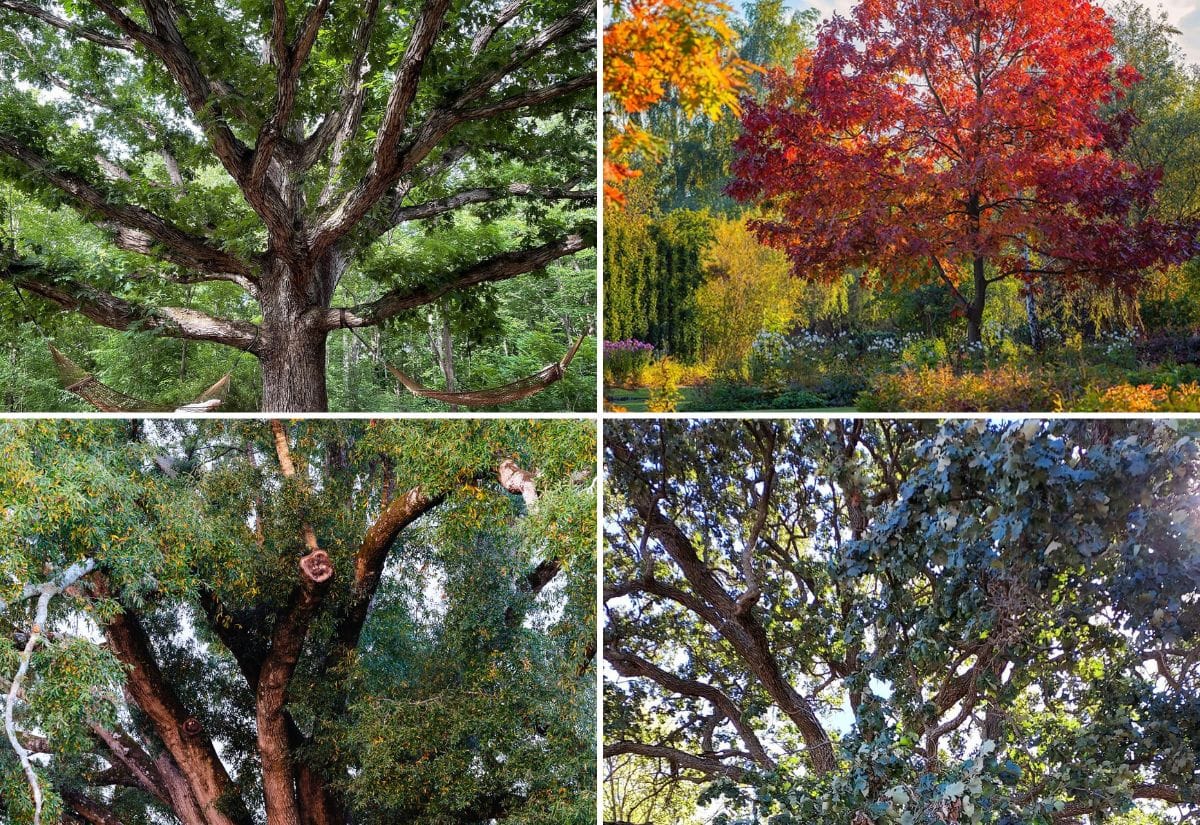
Known as forest monarchs, oak trees (Quercus spp.) symbolize resilience and sustainability. Over 500 oak tree species belongs to the Quercus genus, sharing a family with beech and chestnut in the Fagaceae family. Their forms vary as trees or shrubs, showcasing a range of deciduous or evergreen leaves. Red oaks flaunt scarlet leaves in fall, while holm and cork oaks with small, evergreen leaves charm urban settings.
Though common in forests, oaks rarely grace parks and gardens, perhaps due to their grand size, slow growth, and understated blooms. The lack of awareness about the genus’s diversity might also limit their selection.
Oaks thrive across diverse geographies, from temperate to tropical mountain terrains, spreading from Mexico to Southeast Asia, reaching to New Guinea. Numerous oak varieties native to North America, each adapted to a specific regional condition. While woodworkers treasure oaks, they also serve as stately ornamental trees, ideally standing alone in a garden.
Beyond aesthetics, an oak tree serves a broader cause. Its broad leaves and sprawling branches offer cool shade, providing summer relief and contributing to local ecological balance.
The challenge lies in choosing the ideal oak types for your garden.
Learning about different oak varieties not only sharpens your ability to identify different types of oak trees in the wild but also helps decide which oak best suits your landscape, nurturing an appreciation for the beauty these shade trees offer.
What Is Special About An Oak Tree?
Planting an oak tree is akin to a long-term investment in nature’s bounty. Most oaks grow large yet at a slow pace, meaning it’ll take a fair share of years before they stretch out their branches to provide generous shade.
Yet, the wait is rewarding. The numerous oaks in parks, campuses, and rural estates testify to this. Those who planted them knew the enduring value oaks would add to the landscape.
Typically, oak trees have large rounded canopies holding either deciduous or evergreen broad leaves. Their ample foliage blocks substantial sunlight, creating a cool microclimate below.
Picture a house bathed in full sunlight. During a heatwave, maintaining a comfy temperature indoors becomes a struggle, escalating electricity bills due to constant air conditioning.
However, a mature oak on the south side of the house can change the game. Its shade naturally cools the house, reducing reliance on electric cooling systems, a nature-friendly way to cut down energy costs.
Support for Forest Species
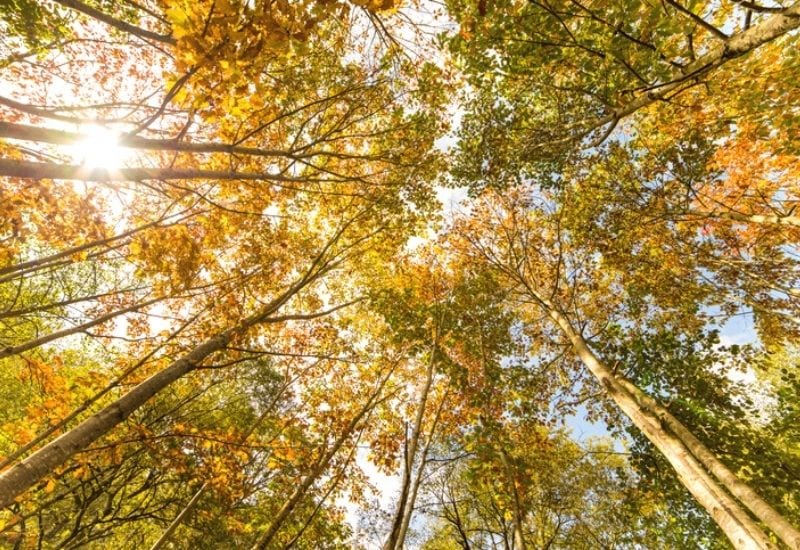
Oaks prove beneficial not just for homeowners, but also for native woodland dwellers. Many species depend on oak trees for support.
Sometimes this support is quite literal. Oaks often serve as preferred nesting sites for various animals like squirrels and birds, who find home among their branches.
Besides shelter, oaks offer a bounty of food, notably through their abundant acorn production.
Mammals feast on these acorns, and also stash them underground for leaner seasons.
Occasionally, these critters forget their acorn stash spots, temporarily losing a food source.
Yet, this forgetfulness bears fruit in the long run, literally. Under the right conditions, the forgotten acorns germinate, embarking on a journey to grow into majestic oak trees.
Oak Genera
True oaks fall under the Quercus genus, a member of the beech family, Fagaceae, originating from the Northern Hemisphere.
Quercus is a diverse genus, encompassing around 600 oak species. In the United States, oaks prominently feature across many forests, and their prevalence over centuries makes them highly recognizable trees.
Although all species within the Quercus genus incorporate “oak” in their common name, this term isn’t exclusive to them.
The common name “oak” also appears in other genera. For instance, stone oak belongs to the Lithocarpus genus, also a part of the Fagaceae family, like Quercus.
Diverging further, silver oak, or Grevillea robusta, falls under the Proteaceae family, unlike the beech family members mentioned earlier.
Similarly, Allocasuarina fraseriana, known as sheoak, is from the Casuarinaceae family prevalent in Australia.
This illustrates the ambiguity of common names. Despite sharing the “oak” tag, silver oak, stone oak, and sheoak don’t qualify as true oaks since they don’t belong to the Quercus genus.
Common Oak Tree Varieties
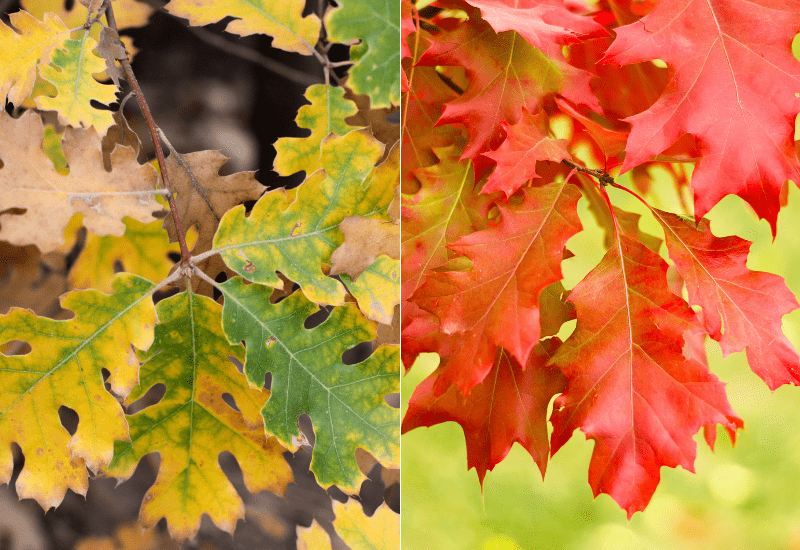
Oak trees are broadly categorized into two main groups: the white oak group and the red oak group, each encompassing a variety of species.
It’s key to note that these broad categories shouldn’t be mistaken for the individual species sharing their names. For instance, while there are trees specifically called “white oak” and “red oak,” these names represent just a single species within their respective categories.
To give you a clearer picture, let’s list some standout species from both groups:
White Oak Group includes:
- White Oak
- Swamp White Oak
- Bur Oak
Red Oak Group includes:
- Red Oak
- Black Oak
- Scarlet Oak
A general distinguishing feature between the two groups is the shape of their leaves. Typically, the white oak species have leaves with rounded lobes, while the red oak species exhibit leaves with sharply pointed lobes.
While it’s useful to be aware of these broad categories, diving deeper into the unique traits of individual oak species provides a richer understanding of these magnificent trees.
How Do I Identify An Oak Tree?
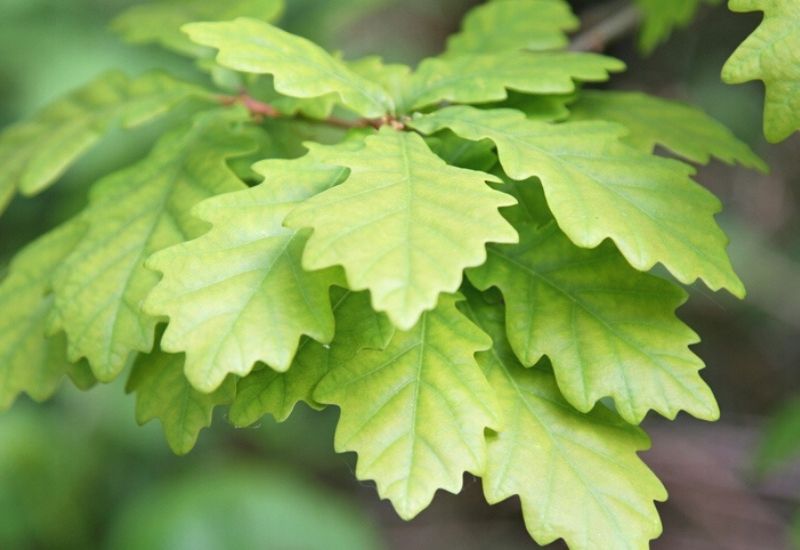
If you have an oak tree on your property, you might be curious, “Which majestic type of oak is this?” identifying its exact species can be an engaging endeavor. Oak trees have distinct features which can aid in their identification, although the presence of natural hybridizations in areas with two species can sometimes muddy the waters.
Here’s how you might go about identifying the type of oak tree you have:
By paying attention to these features and considering the local ecology, you’ll be well on your way to identifying the oak tree on your property.
19 Types of Oak Trees For Your Landscape
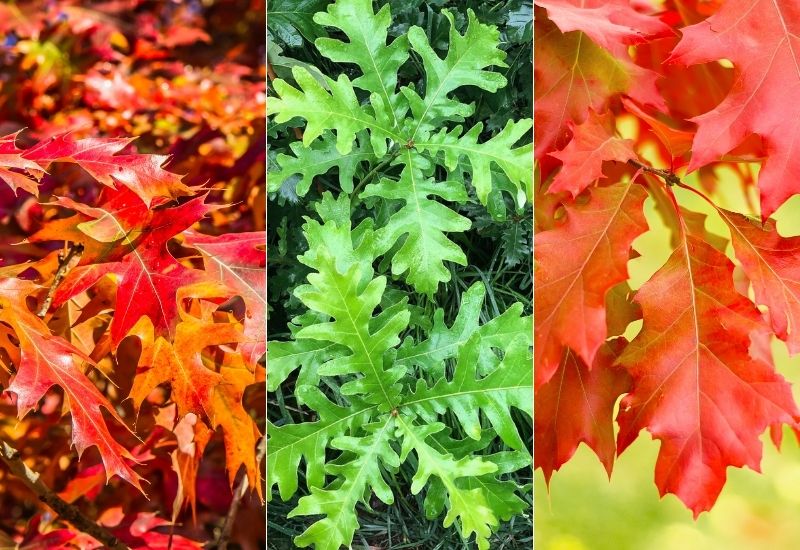
Now that you’ve gotten a glimpse into the diverse world of oaks, let’s delve deeper to understand what sets each species apart. The charm of individual oak species captivates many, with preferences varying from growth patterns and leaf shapes to their overall aesthetic appeal.
Choosing the right oak for you involves distinguishing between these unique types. Once you have a grasp on the differences, you’re well on your way to picking the perfect oak that harmonizes with your landscape. Here are 19 fantastic oak varieties to consider.
1: Quercus Alba (White Oak)
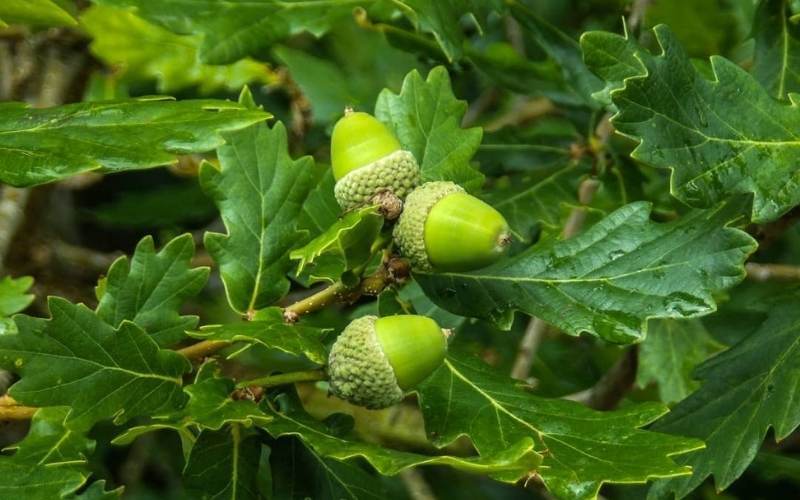
The white oak might take its time to grow, but once mature, it’s a sight to behold. As it soars to incredible heights, its vast canopy stretches out, offering generous shade beneath.
Its distinctive leaves, with their signature rounded lobes, usually have seven lobes each. Come fall, while most oaks stay green, the white oak flaunts deep crimson leaves – a splendid exception in the oak family.
Its acorns, roughly an inch long, either stand alone or come in pairs, with their caps covering about a quarter of their length.
To thrive, the white oak prefers full sunlight and damp acidic soil. Patience is key with this tree; even in ideal conditions, it’s a slow riser. However, the wait pays off. The towering, majestic presence of a mature white oak is nothing short of breathtaking.
Quercus Rubra (Red Oak)
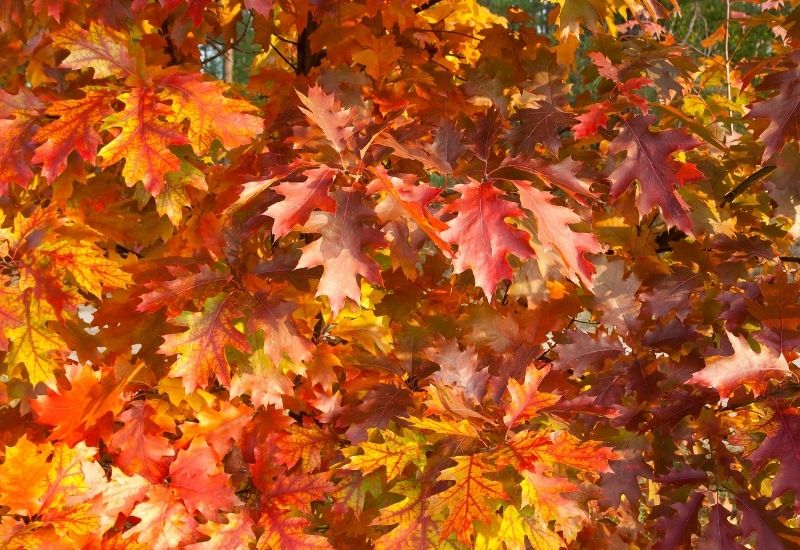
In many regions of the United States, the red oak stands as a hallmark of the forest, generously populating the woodlands of the country’s eastern half.
The leaves of the red oak highlight the differences between red and white oaks, sporting seven to eleven lobes with pointed tips.
With a unique blend of brown and grey, the bark of red oak reveals a character all its own. As it matures, wide flat-topped grey ridges form, separated by shallow grooves, adding texture to its towering presence.
Unlike many of its oak siblings, red oak grows relatively quickly, making it a rare gem among its kind.
For a thriving red oak, plant it in moderately moist soil under the full embrace of the sun, favoring areas with lower pH soils.
As a native specimen, the red oak is a cornerstone of its ecosystem, shaping the very essence of the U.S. forests. Without this grand deciduous tree, the tapestry of America’s woodlands would undoubtedly wear a different face.
Quercus Velutina (Black Oak)
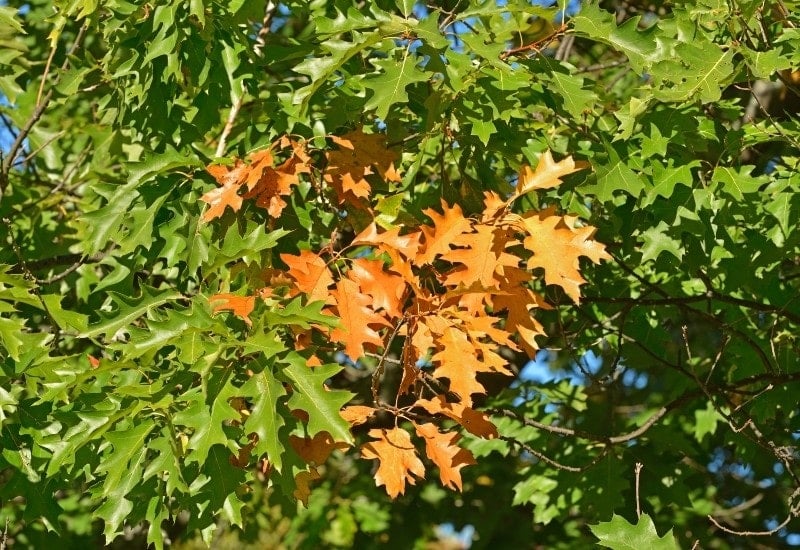
At a glance, black oaks and red oaks seem like twins, yet there are a few subtle differences that will help you with identification.
While both magnificent, the black oak is slightly smaller and has a knack for thriving in drier soils. The leaves of a black oak, though similarly lobed, have a richer, glossier hue, displaying a dark green glamour.
Identifying black oak on a whim can be tricky, but the tale of the bark and acorns tell a clearer story in distinguishing the black oak from its red counterpart.
The acorns of both trees are about ¾” in length, yet their caps tell different tales. While the red oak’s cap modestly covers about a quarter of the acorn, the black oak’s cap generously envelops more than half of it.
The bark of the black oak, living up to its name, darkens to a near black as it matures, showcasing deep fissures and ridges. These ridges are interspersed with frequent horizontal cracks, offering a textured spectacle.
Though it might pose a small challenge to identify, the black oak stands as a captivating native deciduous shade tree, waiting to grace landscapes with its understated beauty.
Quercus Palustris (Pin Oak)
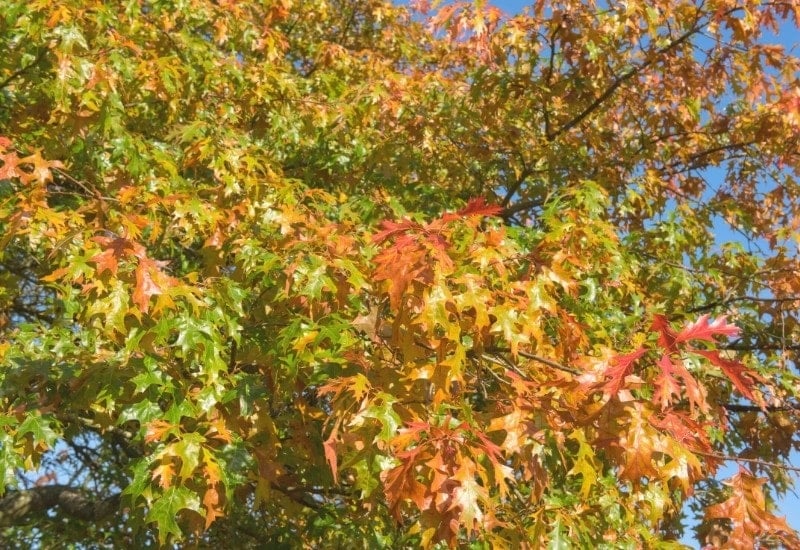
Pin oak is another generous shade-giving oak tree. However, this tree is far more likely to grow in urban settings rather than living exclusively in woodlands.
Because of its tolerance for pollution and poor soils, pin oak is popular as a street tree. It also commonly grows in parks, golf courses, and college campuses.
Pin oak has an interesting branching habit. The mid-tier branches grow straight out at a 90-degree angle from the trunk. The upper branches grow in an upward direction. The lower branches often droop downward.
Interestingly, the leaves have a tendency to adhere to this pattern. These leaves are a bit thinner than other oak leaves. The pointed middle lobes often grow out at a right angle much like the mid-level branches.
It is common for pin oak to experience chlorosis. This results from alkaline soils and causes the leaves to turn yellow.
Despite this common problem, pin oak is one of the most popular oak trees. Plant in full sun with ample soil moisture. Then sit back and enjoy the shade and unique growth habit of pin oak for years to come.
Quercus Bicolor (Swamp White Oak)
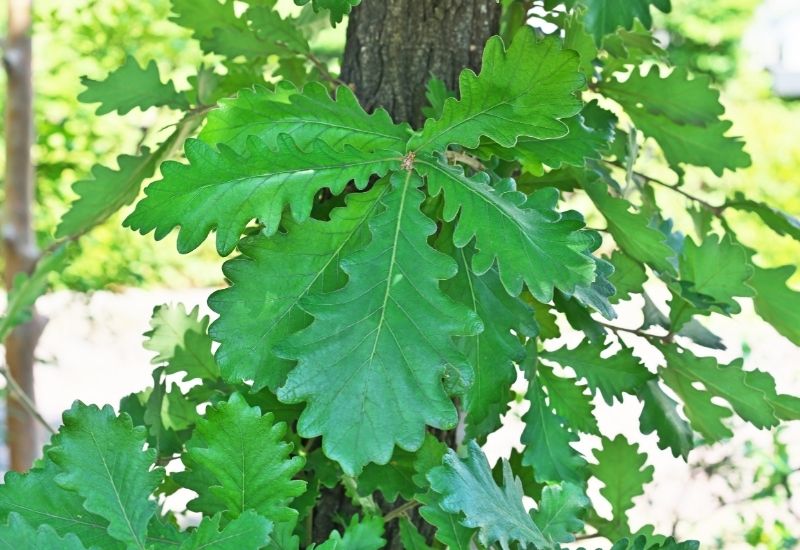
Swamp white oak is an intriguing variation on the typical white oak. This tree thrives in moist soils which gives it its common name.
Regarding physical characteristics, there are a few that set swamp white oak apart from its relatives.
The first relates to its overall form. Swamp white oaks are just as large and spreading as white oaks. However, their branches offer a different effect.
These far-reaching branches often sprout a higher number of secondary branches. At times, the lower branches form a large arch that curves back towards the ground.
The leaves feature rounded lobes. But the separation between lobes is quite shallow.
Swamp white oak grows best in acidic soils in full sun. It is deciduous and usually lives in low-lying areas where water gathers.
Quercus Robur (English Oak)
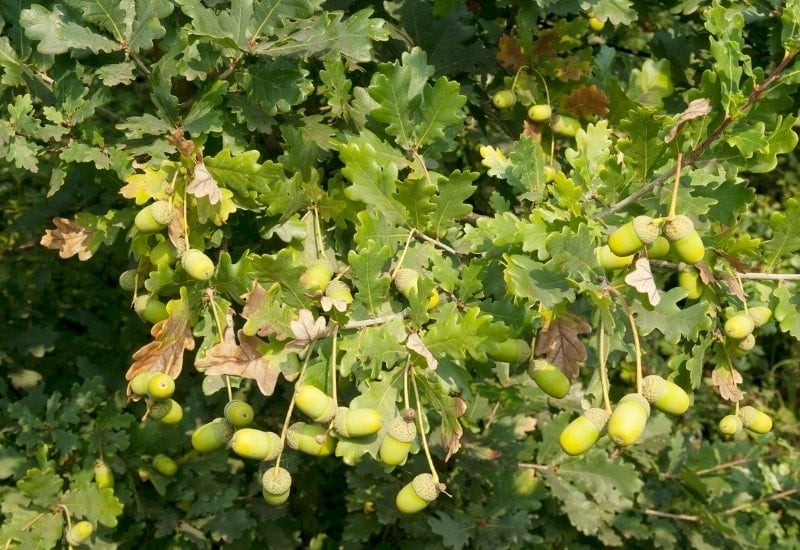
English oak is native to Europe and western parts of Asia. In England, it is one of the primary sources of timber.
This oak tree looks a lot like white oak. Its leaves have a similar shape and a similar number of rounded lobes.
The acorns are an important identification trait for this tree. These acorns are elongated compared to other oak trees. The cap covers about 1/3 of these oblong fruits.
This tree typically as branches that grow from the lower portion of the trunk even at maturity. This gives the trunk a short appearance.
The bark on that trunk is dark grey or even black at the time. It has many ridges and fissures.
Overall, the form is broad and rounded. In addition, English oak can grow to be very large. Some specimens even grow taller than 130 feet.
In general, this tree is low maintenance. However, it can have some problems with powdery mildew.
Quercus Coccinea (Scarlet Oak)
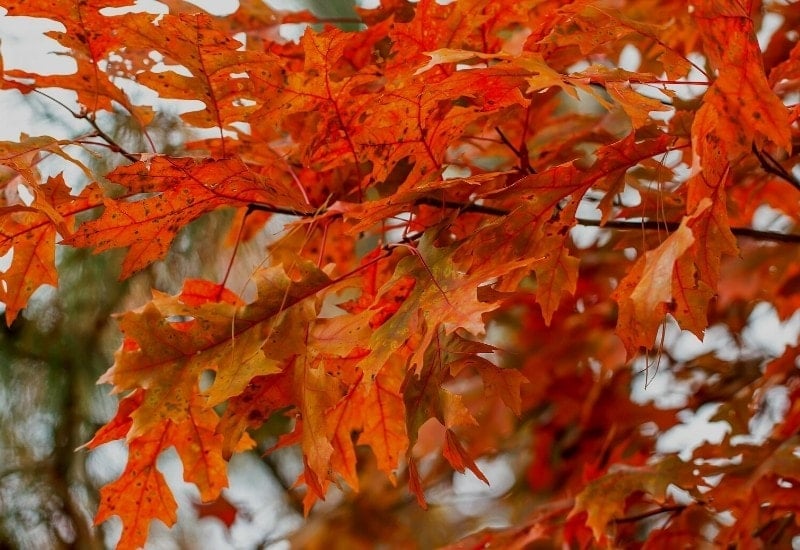
As you might expect, scarlet oak offers deep red fall color. In some cases, this coloration can be inconsistent. But, this red is often so vibrant it rivals some more popular autumn trees like red maple.
But this no reason to ignore this tree. In fact, the leaf color is appealing even in the summer months. At that time, the tops of the leaves are a rich glossy green color.
The form of the leaves is thin like the pink oak and also has pointed lobes. Each leaf has seven to nine lobes and each lobe has a bristly tip.
A mature scarlet oak has a form that is rounded and open. It often reaches 50-70 feet tall with a slightly smaller spread.
Scarlet oak grows best in acidic soil that is also somewhat dry. Plant this oak if you are interested in a large shade tree with striking fall colors.
Quercus Virginiana (Live Oak)
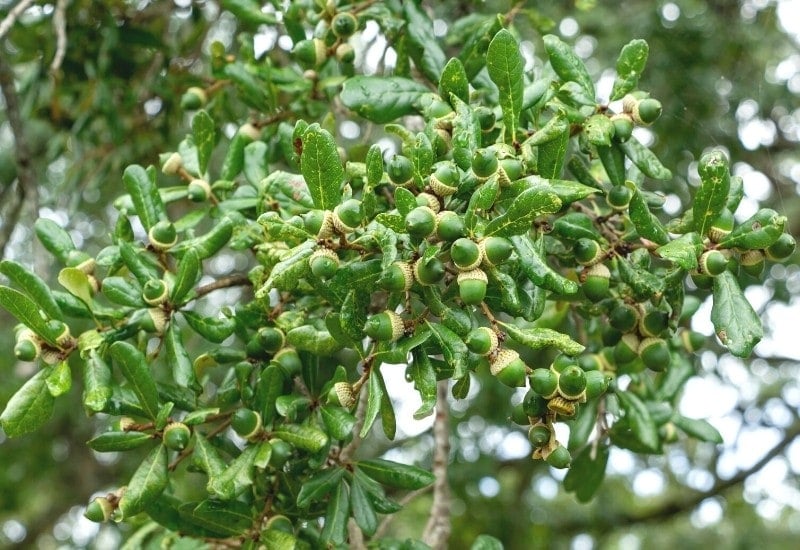
Live oak grows in warmer regions of the United States. In the south, it is a main component of large estates and former plantations.
If you ever see a live oak, it quickly becomes apparent why people plant this tree so often. It is a large shade tree with a spread that can exceed, and even double the height.
Another unique aspect of this oak is that it is evergreen while many other oaks are deciduous. The leaves also have a shape that differs from what most people think of when they imagine oak leaves.
Live oak leaves are simple elongated ovals. They are about one to three inches long. To add to their differences from other oaks, they are also evergreen.
While planting this tree in a small area is ill-advised, this tree is a great option for large areas zones eight to ten.
Live oak will grow best in full sun with moist soils. In its most attractive form, you will find mature live oaks with spreading branches covered in Spanish moss.
Quercus Laurifolia (Laurel Oak)
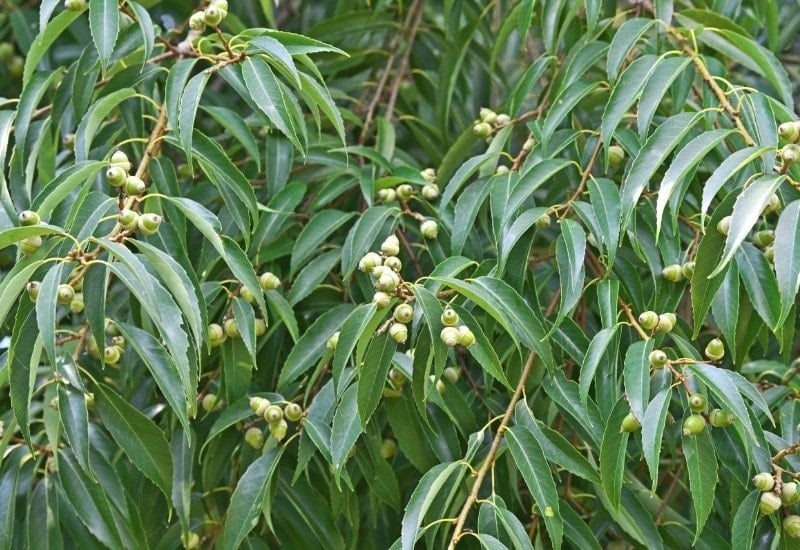
Laurel oak is an interesting tree because it has both evergreen and deciduous characteristics. While the leaves do eventually fall, this does not occur until late in February. This gives laurel oak the appearance of an evergreen for much of the winter.
This species is native to the southeastern part of the United States. It is another large shade tree with a height and spread that match each other.
The leaves of laurel oak are reminiscent of laurel shrubs. They have an elongated elliptic shape with mostly smooth margins. Their color is often dark green
Laurel oak thrives in acidic soils. In its native range, it inhabits warm coastal areas. The further north this tree grows, the more deciduous it becomes.
Plant this tree if you are in a warmer region and you want an oak that stands out from the rest.
Quercus Montana (Chestnut Oak)
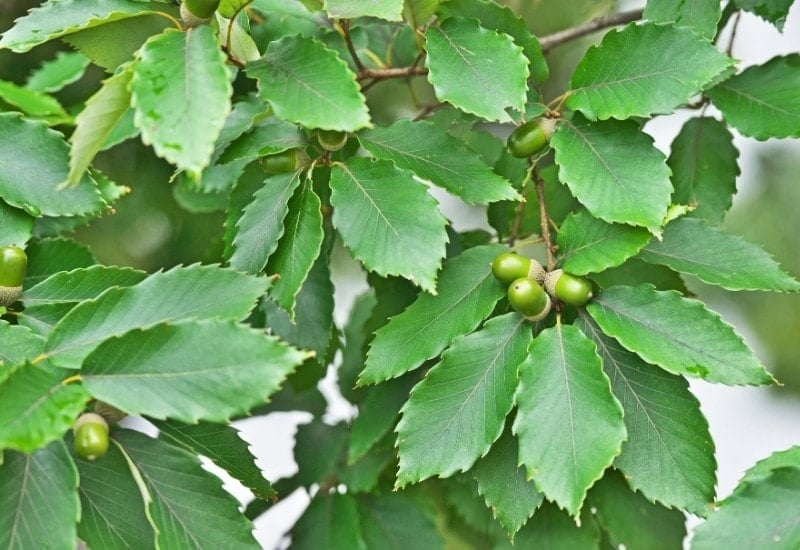
In the wild, chestnut oak inhabits rocky areas at higher elevations. It is native to the eastern United States.
This tree is deciduous. It has a broad rounded form. Because of its adaptability to dry soils, it sometimes carries the name rock oak.
The name chestnut oak comes from the fact that it shares some visual characteristics with chestnut trees. The most notable of these is the bark which is brown with a corklike texture.
The leaves of chestnut oak are different than most oaks. These leaves are obovate with coarse serration. They look similar in shape to some beech trees.
Despite adapting to poor soils, this tree can have numerous diseases. Among these are root rot, cankers, powdery mildew, and even chestnut blight.
But if you can avoid these problems, chestnut oak is a good shade tree option for well-drained soils.
Quercus Prinoides (Dwarf Chestnut Oak)
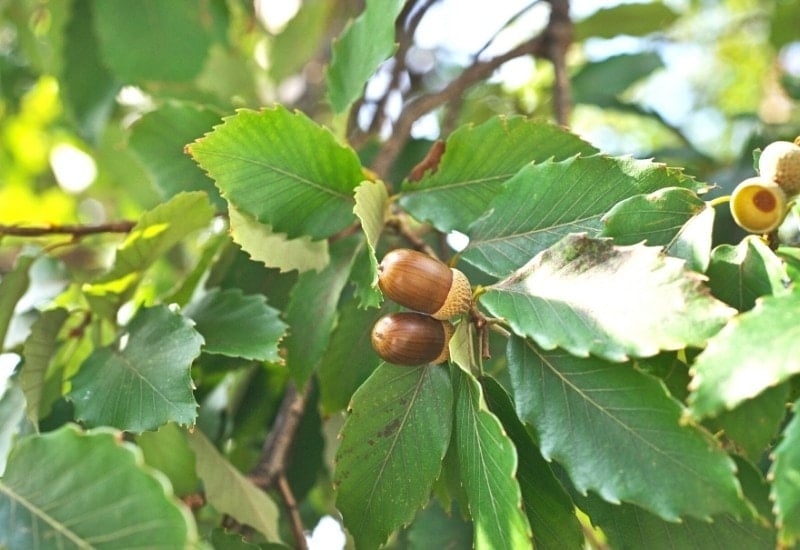
Dwarf chestnut oak grows as a large shrub or as a small tree. It averages about 15’ feet in height and spread at maturity.
Many oaks have a bitter taste to their acorns. This bitterness is far less present in the acorns of dwarf chestnut oak. This results in a flavor that is far more favorable to wildlife.
Dwarf chestnut oak leaves are remarkably similar to chestnut oak leaves. This native shrub also has a deep taproot. This characteristic makes transplanting a significant challenge.
Dwarf chestnut oak can adapt to some dry soils although this is not its preference. It is also tolerant of limited amounts of shade.
Quercus Gambelii (Gambel Oak)
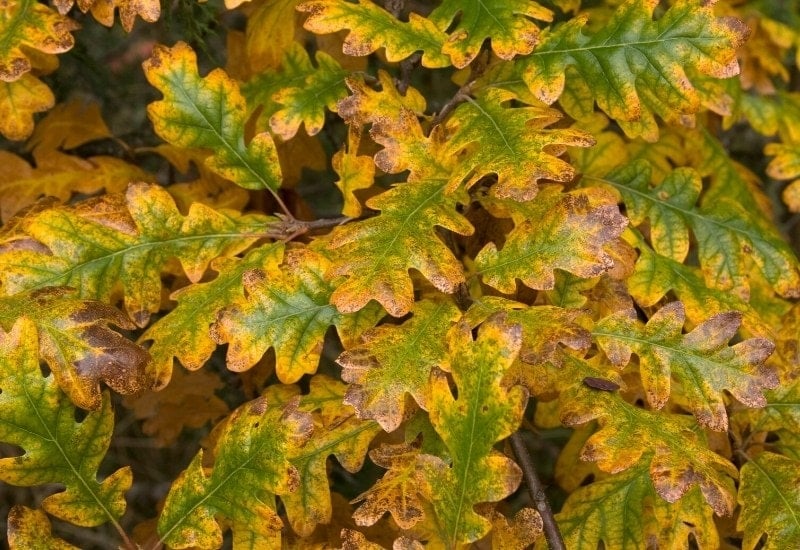
Gambel oak another variety of oak that is on the smaller side. While not a true shrub, this small tree only grows to an average mature height of 30 feet at most.
The plant has a rounded form throughout its long life span which can reach 150 years. In older age, it takes on a weeping form that requires plenty of space.
Gambel oak is valuable for its ability to adapt to both moist and dry soils. Its leaves are deciduous with rounded lobes.
Another notable feature of this plant is its high production of acorns in the fall. These serve as a food source for animals in winter.
Quercus Nigra (Water Oak)
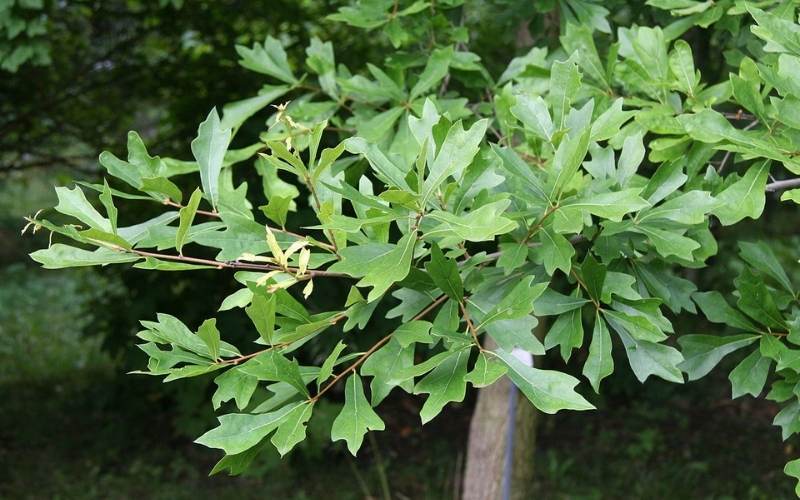
Water oak is a species native to the southeast United States. It grows naturally near streams as the name implies.
This tree is semi-evergreen. Old leaves fall in the winter. However, in some cases, they will persist through the winter.
The shape of the leaves is unlike any other oak. They have a narrow oval shape. That shape is consistent from the petiole to the midpoint of the leaf.
The beyond that mid-point, three subtle rounded lobes give a wavy shape to the outer half of the leaf. The leave color is green with some hints of blue.
Like many oaks, water oak has a broad rounded canopy. The trunk can be exceptionally thick. At times it will be around five feet in diameter.
Even though this tree has a sturdy appearance, it is actually weak wooded. Be careful about planting this tree near your house. The branches are prone to breaking especially when carrying any sort of extra weight.
Quercus Macrocarpa (Bur Oak)
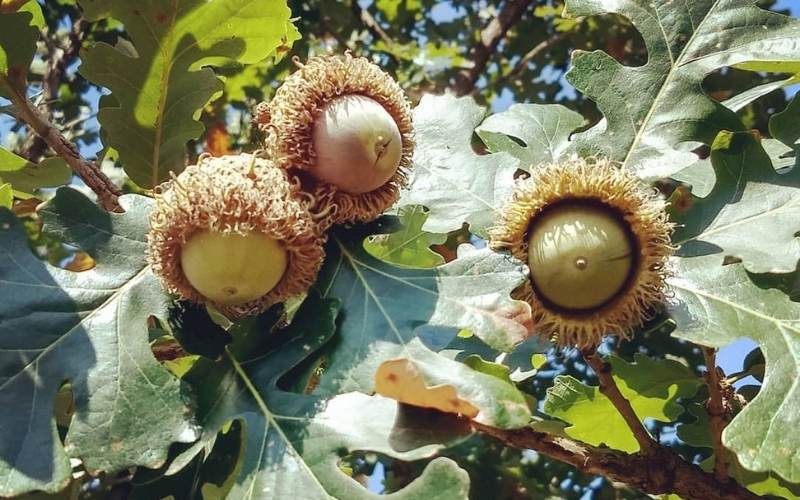
As you may have noticed, bur oak is one of the few trees on this list with a preference for alkaline soils. This preference is s slight but explains why bur oak so often grows where limestone is nearby.
But oak is a prominent native plant in prairie regions of the central United States. In youth, it has an oval or pyramidal for. As it grows it becomes more open and rounded.
The leaves have an odd shape as well. They are far wider at the ends compared to the base with is narrow. Both halves of the leaf have rounded lobes.
The acorns have a strange appearance too. These acorns are nearly entirely covered by the cap. The cap itself is heavily fringed giving a fuzzy appearance.
Bur oak is vulnerable to many different diseases. But as long as it does not contract one of these numerous diseases, it is low maintenance and a great addition to large lawn spaces.
Quercus Falcata (Spanish Oak)
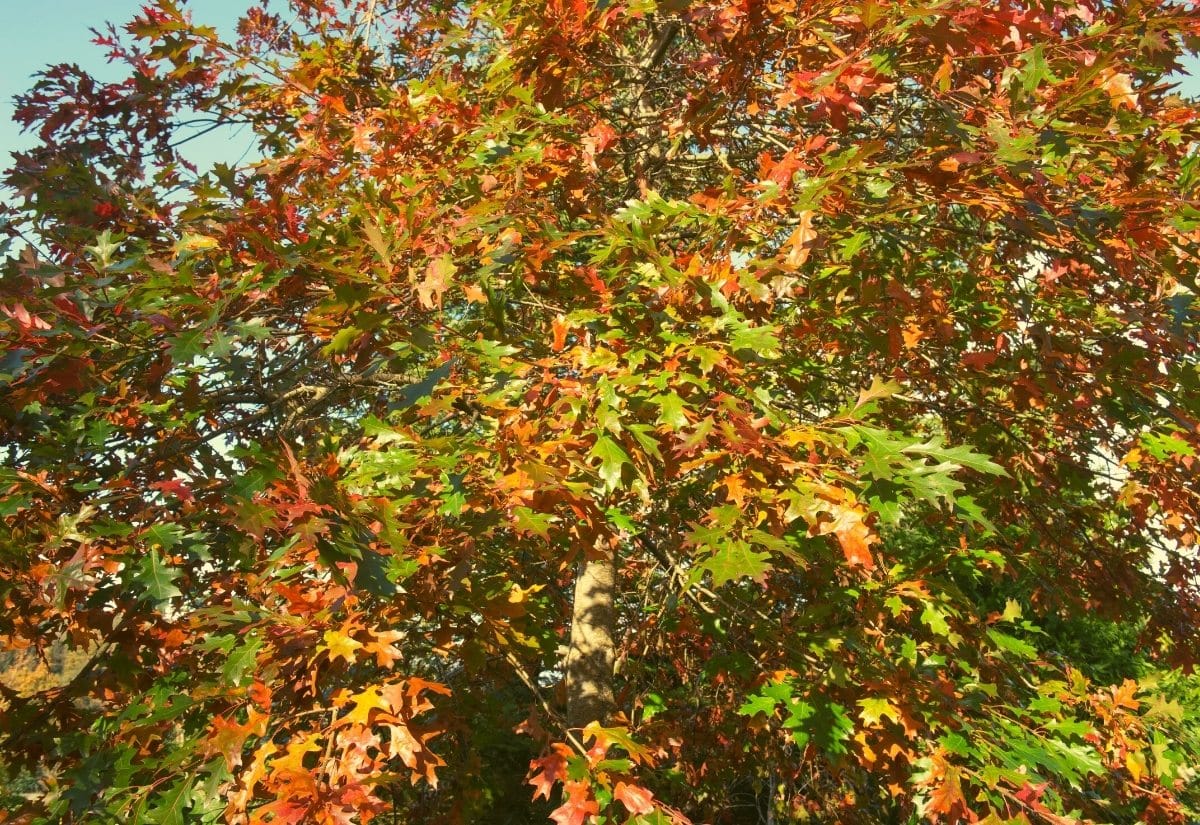
Spanish oak is a deciduous oak variety that also goes by the name southern red oak. But don’t expect to see much red on this tree.
Rather than turning a pleasing shade of red in fall, instead, the leaves simply turn brown. While this fall color is disappointing, there is plenty of aesthetic value in this tree.
A sturdy strait trunk supports an open crown. The canopy consists of leaves with an intriguing shape.
That shape includes a rounded base and three trident-like lobes at the outer end of the leaf. The middle lobe is often the longest but the leaf shape overall shows variation.
Spanish oak is most likely to grow in upland regions in the American south. At the time, it ventures down into valleys as well.
If you plant this tree, provide full sun and acidic soil. While well-drained soil is best, this tree can survive some temporary flooding. However, the root system is known to be quite sensitive to damage. Plant near any construction area is a significant risk.
Quercus Stellata (Post Oak)
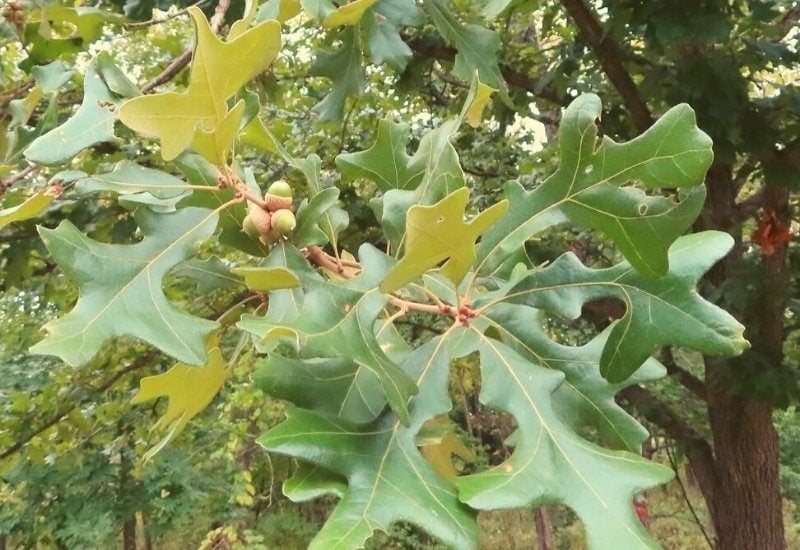
Compared to many other oak species, post oak is generally smaller. But remember that this is all relative.
Post oak is still suitable as a shade tree as it can reach 50feet in height and spread.
This tree has a preference for moist acidic soils. But don’t think that they are limited to areas with those characteristics. Instead, post oak is very adaptable when it comes to soil types.
For example, post oak can survive in exceptionally dry soil in many cases. Because of this, post oak often grows on mountain slopes where the soil is rocky and drains quickly.
In keeping with the oak stereotype, post oak has useful hard wood. The fact that this tree is often used to create fence posts is the inspiration for the common name.
Quercus Phellos (Willow Oak)
When you see the leaves of willow oak, it is no surprise that it carries that name. While part of the oak family, the foliage of willow oak bears little to no resemblance to other oaks. Instead, it is nearly identical to the foliage f common willow trees.
To add further contrast to common oak species, willow oak Is a fast-growing tree. When growing in the wet low-lying areas it calls home, this tree races towards its mature size.
At maturity, this oak is narrower than others. Rather than having a perfectly-rounded canopy, willow oak is just a little more than half as wide as it is tall.
Willow oak leaves often turn gold or brown in the fall. They also carry acorns that are an important food source for animals in the American southeast.
Beware that this oak can have numerous diseases including oak wilt, oak skeletonizer, and much more. Despite this, willow oak is usually long-lived and a great option for planting along with ponds and other natural water features.
Quercus Ilex (Holm Oak)
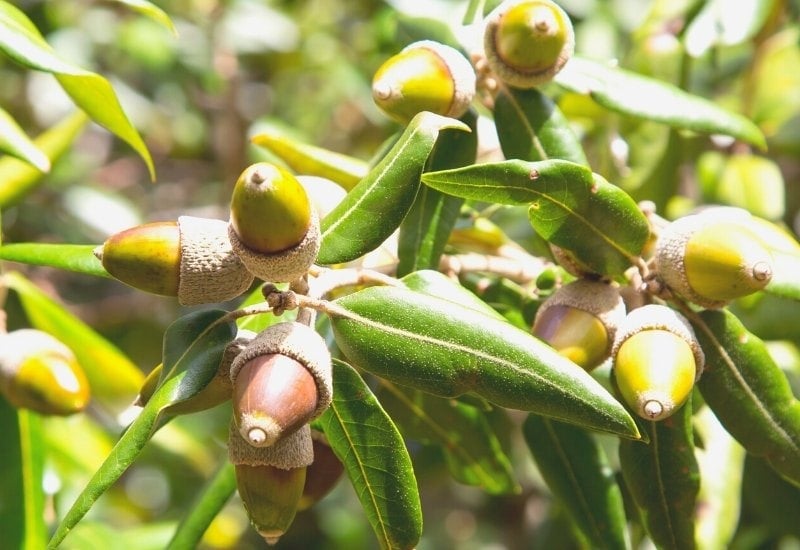
Holm oak is one of the rarer broadleaf evergreen oaks. The leaves on this tree are dark green with sharp edges like a holly shrub. In size, they are about one inch wide and three inches long.
Holm oak is native to the Mediterranean region. As such, it survives only in warmer regions. These include zones 7-10.
Overall, the form of holm oak is large and rounded. Its foliage is dense and grows on branches that are generally upright in their growth habit.
A textured cup covers about half of the acorn. These acorns tend to ripen in the early fall.
If you are in a warmer region, holm oak is a great evergreen tree option for you.
Conclusion
Oaks trees deserve the popularity they’ve achieved. The genus plays a vital role in forest ecosystems throughout North America. Oaks are also attractive. You can’t help but admire the scale of these trees at maturity.
From afar, wide oak canopies add rounded forms to the landscape. Beneath those dignified branches, you will find the relief of cool shade on hot summer days.

Written By
John Haryasz
John Haryasz is a writer with a background in landscape architecture. His education includes a Bachelor of Science in landscape architecture from UMass, Amherst with a minor in psychology. Following graduation, John worked in a small landscape architecture office. In this role, he led many successful projects in Berkshire County, MA. After a few years, John began offering freelance design services. He has since produced designs for projects across the country. As a writer, John aims to share knowledge while promoting engagement with the outdoor world.

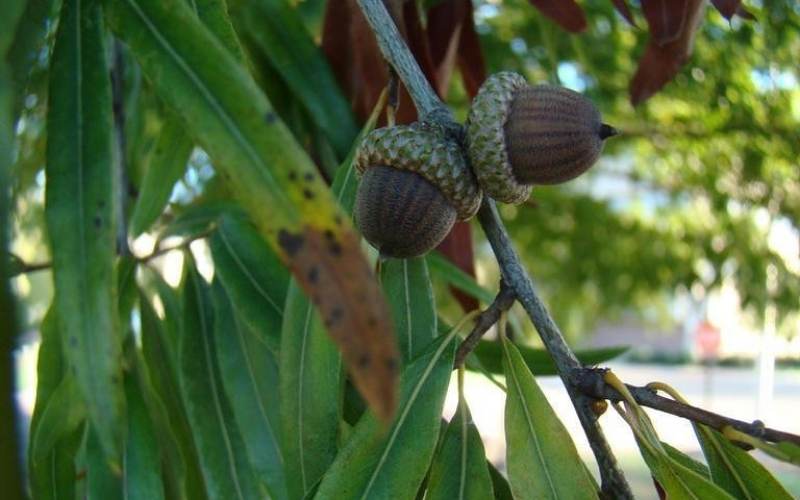
Monterrey Oak?
Yes, Mexican White Oak, is an amazing tree.
A friend has given me several plants that she calls Cedar oak. I don’t find that in any list of oak trees. Is it a true oak?
Thanks for your help.
It’s probably a Cedar Elm. I’ve heard those called the poor man’s live oak but they don’t really bear much resemblance
I have two huge oak trees they long trunks the canopy is as wide as the trees are tall the long spreading branches point slightly downward the acorns are small and short, the leaves look similar to a white oak but the trunks are tall and long, the bark is grayish-white almost and has vertical groves. Wh a t king of oak trees do I have? Mike Tracy
I have an oak tree who’s “acorns” is a round, wrinkled, nut-looking object. What kind of tree do i have?
I think we’ve determined my tree has Oak Gall. These seem to be oak apples!
thank you for the information. We live in Reston VA. My yard and the bordering “common” area have experienced a lot of oak die off in the past few years. Mostly, I think, it is from borers, and mostly seems to be affecting the chestnut oaks. To try to save the remaining oaks, I have started pulling soil and mulch away from the root zone to expose the bark skirt. It seems to help. I remember my grandfather saying how harmful it is for trees to have soil against the trunk. Any thoughts on this?
The loss of a few large trees recently has also exposed nearly an acre or so of fresh forest floor. I have noticed many young oaks growing in this area and am planning to try to get a new grove of oaks established by thinning out some of the faster growing competitors.
Yes I do believe tree troubles usually start at the base of the trunk. Piling organic or inorganic materials around a tree’s trunk, also called “volcano mulching,” can kill a tree by creating conditions that weaken its ability to fight disease and pests.
I have a 35 to 40 year old oak tree in front of my house. It has green leaves that turn brown but never pretty colors. It produces round green and brown acorns, some years more than others. the last two years it is dropping little fuzzy balls like the size of a pussy willow after the acorns drop. I’d like to know what those are and what kind of oak it is.
Forgot Lacey Oak (Quercus laceyi) on your June 7, 2022 oak article.
Is there a difference between old english and Irish oak
Yes, there is a difference between Old English Oak and Irish Oak, although they both refer to the same species, Quercus robur. The difference lies in their geographical origin and the characteristics attributed to them based on that origin.
Old English Oak refers to oak trees indigenous to England. These trees have been a symbol of strength and durability for centuries, and English oak wood has been widely used in furniture, construction, and shipbuilding.
Irish Oak, on the other hand, refers to oak trees native to Ireland. Irish Oak wood is known for its distinctive, attractive grain patterns and color variations, which are often lighter and more golden than English Oak. The term “Irish Oak” is often used to describe the appearance of the wood rather than the specific trees or the origin of the lumber.
Both Old English Oak and Irish Oak belong to the same species, Quercus robur, which is also known as the English Oak, Common Oak, or Pedunculate Oak. This oak species is native to most parts of Europe, western Asia, and parts of northern Africa. While there are subtle differences in appearance and local characteristics, the primary distinction between Old English Oak and Irish Oak lies in their geographical origin.
Thanks for sharing this research. I am looking to learn more about blue oaks that grow in my region and how to keep them healthy.